|
X.
|

|
Several years ago death removed from the Paris art world one of its most
curious characters in Charles Francois Edouard de Beaumont.
He was born at Lannion, in 1821, and was the son of a sculptor. His father taught him to draw,
and sent him then to the painter A.F. Boisselier to continue his studies. Antoine
Felix Boisselier was a painter of history and historical landscapes, an artist of
sound technique and a good master. Influenced by him de Beaumont at first took
to landscape painting, in which field he made his debut at the Salon of 1838.
Some three years later he turned his attention to mythological and allegorical subjects,
in which his success was soon assured. He delineated the female figure with the
most seductive grace, and was a pure and charming colorist. Painting in watercolors and in
oils with equal facility, his works found a ready market, and he also prospered by
contributing illustrations to various publications. But the man was of a sensitive
nature, and disappointment of his ambition soured him. Year after year he exhibited at
the Salon without receiving official recognition, and he was nearly fifty years of age
before he received his first medal.
This encouragement
came too late. He had become a recluse and a misanthrope. But for the persuasions
of Alexandre Dumas, who was his closest and almost his only friend, he
would not have exhibited at all. He lived alone, among his ancient arms and
costumes, of which he was a passionate collector, working steadily to distract his
thoughts in his solitude, and disdaining the handsome returns the labors of his
gifted pencil brought in, sinking into ever deeper gloom until, without being positively
insane, as the great landscape painter Theodore Rousseau became from the
same cause, he grew into a monomaniac on the subject of the injustice with which
he was treated and which he regarded as the result of an organized conspiracy.
In 1877 he sent to the Salon "A Nest of Sirens," which created a furor. The beauty
of the figures, the grace of the composition, and the charm of the color rendered it
one of the pictures of the year. The subject is the endeavor of the sisters of the
sea to lure the bark of Ulysses to wreck upon the reefs. The decoration of the
Legion of Honor was the result of this superb work, but even this did not tempt
the painter from his course. He persisted in his bitter moodiness until his death.
Among his later productions were several series of beautiful water-color drawings,
to illustrate luxurious editions of "Bluebeard" and other fairy-tales.
|

|
Alceste, the heroine of Nathaniel Sichel's picture, was the daughter of Pelias and the wife of Admetus,
according to mythology. She was devoted to her husband, who was one of the Argonants, and a King in Thessaly,
and when he was threatened with death she surrendered her own life to save him, her name thus
becoming among the Greeks a synonym for wifely virtue and self-sacrifice. To restore this model
matron to the world Hercules descended into hell. The story of Alceste provided the foundation for one
of the principal tragedies of Euripides, more than four hundred centuries before the Christian Era.
|

|
Leon Auguste Hodebert was born at Saint-Michel-sur-Loire, in the Department
of Indre-et-Loire, and was a pupil in Paris of Galembert. He is an esteemed painter of portraits
and a master of the figure. His picture, representing a model preparing to pose for an artist by whom
she has been engaged, was his contribution to the Salon of 1893.
|

|
In his "Leda" Emmanuel Benner shows the beautiful
wife of Tyndarus and mother of Castor and Pollux seated on the river bank arranging
her hair after her bath, while the enamored Jupiter, full of the eagerness of passion,
approaches her on the water in the guise, which he has assumed, of a swan.
|

|
"The Fisher" by William Kray is one of his pictures founded on
the legend of the Rhine. This tale recites how a fisherman once inspired a water sprite with
such a love for him that she could not overcome it. In order to secure possession of him, she came, while
he was fishing, up on the bank of the river and held him in
such thraldom by her charms that he did not notice the rising of the tide until it was too late,
when the waters engulfed him and his temptress carried him away to her cavern deep under the waves.
|

|
The ancient Egyptians held their dead in the most devout reverence. Those even of the poorest were
embalmed with many ceremoies, and in every wealthy house was a private temple in which the statues
of the departed were worshipped. Elegiac music and songs were the accompaniment of these ceremonials.
The picture by Miss Coomans represents some Egyptian princess who has lost one whom she has reverenced
or loved, and to whom, as she sits in the throne chair of her house, her slaves sing the elegy to the dead.
|
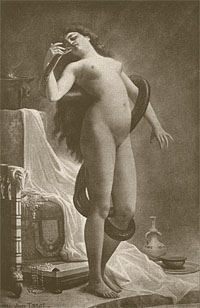
|
In 1862 the literary world of France was treated to a sensation. It consisted in a romance entitled "Salammbo,"
written by Gustave Flaubert, which in the most daring and realistic manner revived the life of ancient
Carthage, at the period of the Punic War, and provided a model upon which numerous realistic novelists
have built themselves up. "Salammbo" took its title from the heroine of the story, a weird creation
who has furnished a type which many painters have essayed to realize. One of the most successful of
these attempts is that of Jules Jean Baptiste Toulot, a pupil of Gerome and a painter of the figure
of much power. He represents Flaubert's heroine as she is about to enter bath, receiving the caresses
of her pet serpent.
|
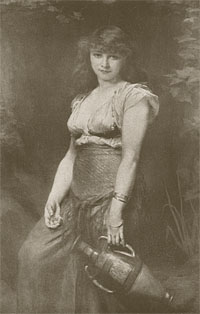
|
"At the Fountain," by Gaston C. Saintpierre, is a study of an Algerian girl, one of his souvenirs of
African travel.
|

|
Gustav Graef is a distinguished German artist, born in 1821 at Konigsberg,
Prussia. He was a pupil of Professor Hildebrandt and Schadow at Dusseldorf, and made his first success
with subjects derived from the "Nibelung" and other German legends. He left Dusseldorf to study in
Antwerp, Paris, Munich and Italy successively, and while he became a strong and popular portrait painter
he adhered for his subject-pictures mainly to the national legendary lore and fairy-tales.
He has painted also a number of decorative compositions of a historical character, and developed
Biblical and mythological motives. "The Soul of the Water Dragon" is an old folk-tale in Germany.
A malignant witch, to be revenged on a queen who has treated her with disdain, transforms her daughter into
a water dragon. The young prince who is betrothed to the princess swears to restore her. His
good fairy consents to assit him, under condition that he suffer her to
metamorphose him into a raven. He consents. Advised by the fairy how to proceed,
he seeks the stream where his enchanted sweetheart has her lair, and finds her sleeping among
the reeds. As directed by the fairy he pecks out one of the dragon's eyes and then seizes its dorsal
fine with his iron beak, when the hideous, scaly skin comes off and the princess stands forth in all
her beauty. At the same moment, by a spell of the fairy, the wicked witch enters into the skin of the
monster and becomes a terrible land dragon. Next the prince is restored to his human form, arms himself,
goes forth and slays the dragon, and being duly united with the princess all live happily ever after in the
good old style.
|

|
On the terrace of an Italian villa of the later Roman period, which overlooks the sea, three young
girls idle away the summer hours. One stretches out on the marble bench, smelling a flower as she
listens to the sweet notes a companion evokes from a double flute, while the third lounges at her side,
with one hand resting on her lute. Miss Coomans has made a charming picture indeed, out of very
simple material, in "Youth's Sunny Hours."
|

|
In "A Dream of Roses," a young girl, reclining on a couch after her bath, covered with a furred robe,
indulges in one of those visions which an interesting novel has the power of inspiring, and which
we know as day-dreams. The artist [Bertha Verree] is the wife of a well-known French painter who has won distinction
at the Salon.
|

|
"A Naiad" is one of the most characteristic and expressive of the ideal pictures of
Charles Landelle.
It was first exhibited at the Salon of 1882. The Naiades were, in Grecian mythology, the nymphs of the
fresh-water lakes, streams, and springs, and part of their duty was
to attend to the nourishment of the plants and flowers which bordered the waters to whose service they were bound.
|
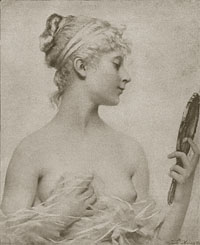
|
Jules Aviat was born at Brienne-le-Chateau, in the Department of Aube, and is a pupil of E. Hebert,
Leon Bonnat, and lafrance. His female portraits are especially exteemed, although he is also strong
in male portraiture. His imaginative pictures are always graceful, refined, decorative in treatment,
and charmingly delicate in color. "A Revelation" is a typical work. In it a young Greek girl,
contemplating herself in a hand-mirror, arrives for the first time at the conclusion that she
is as beautiful as she has wished herself to be.
|

|
A girlish coquete, revelling in the reminscence of some new conquest, is the subject of the picture
by Joseph Coomans. The heroine is a type of the blonde beauty of the women of Greek origin or
antecedents who bore away the palm for loveliness in Pompeii in its prime, when beauty was worshipped
there second only to the gods.
|
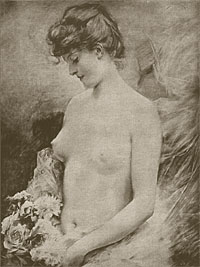
|
Although he resides permanently in Paris, America claims Julius L. Stewart as one of her own artists,
on the score of birth. He was born in Philadelphia. His father was a banker, who settled in Paris
to conduct the European business of his banking house, and his son was educated in Paris. The banker
Stewart was a great art-lover, and one of the very first patrons in France of Fortuny, Raimond de Madrazo,
and Zamacois, for he was especially fond of the brilliant and audacious modern Spanish school.
As young Stewart positively declined to be made a banker, and asserted his intention to become a
painter, he was given his course. He had probably been inspired to his resolution by the artistic
surroundings of his father's house. At any rate, he studied under Zamacois, Madrazo, and Gerome,
but his innate talent broke a path for itself, and his later works suggest none of his masters.
He created a style of his own which has been received in Paris, London, and America as thoroughly
original. He first exhibited at the Salon in 1878, and since then has received many awards of merit.
His "Spring" is one of his higher compositions, and was painted for a decorative purpose.
|

|
J. Albert Begas is a German artist and comes of a family of painters all the members of which
have achieved distinction.
|
|
|
|





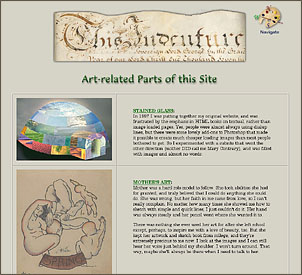



![]() Copyright © 2007, Mary S. Van Deusen
Copyright © 2007, Mary S. Van Deusen